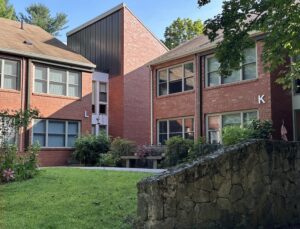Who is a member?
Our members are the local governments of Massachusetts and their elected and appointed leadership.
Mass Innovations, From The Beacon, September 2024

The town of Andover says it has an
“endless laundry list” of energy needs for
the 274 housing units managed by its
Housing Authority.
Hoping to bring the green revolution to public housing, the neighboring communities of Andover, Lowell and Methuen have teamed up to examine the energy-efficiency needs of their housing authorities, and plan to share their findings with communities around the state.
Led by Andover, the trio of Merrimack Valley communities was one of 40 teams named in April to participate in the first round of the U.S. Department of Energy’s Energy Future Grants program, which will provide $27 million in financial and technical assistance for cross-municipal projects that support an equitable transition to clean energy.
After they complete the federal paperwork process, the three communities are hoping to receive $360,740 by this fall to study the energy systems in their public housing properties, identify ways to decarbonize buildings, and improve the quality of life for residents there. If all goes well, the team hopes to be considered for a second round of federal implementation funding.
Merrimack Valley officials said their effort capitalizes on the increased funding opportunities available now for climate-friendly projects, and on the push to provide electrification and decarbonization resources to all parts of society, especially underserved populations.
“Housing authorities, and these older buildings, really give us the opportunity to be innovators, to be leaders, rather than the folks who are being left behind,” said Joyce Losick-Yang, Andover’s director of sustainability and energy.

Methuen owns 453 public housing units
spread out across 15 developments.
The Energy Future Grants program was appealing because it allowed for a wide range of projects and required only a 5% local cost share, said Losick-Yang, who asked other Merrimack Valley communities to partner on the grant application.
The chance to work with Methuen’s housing authority, which owns 453 public housing units, grabbed the attention of Joseph Cosgrove, Methuen’s environmental planner and energy manager. Housing authorities typically don’t have the resources to wade through complex grant applications, he said.
“Housing is a big issue, and we have a housing authority here in Methuen with a lot of capital needs, and they’re kind of an island among themselves,” Cosgrove said.
Cosgrove said the newest building in Methuen’s 15 public housing developments dates back to 1989, and the buildings struggle with inefficient, individual air conditioning units and outdated lighting.
As part of its DOE application, Lowell wrote that its public housing has “many unmet capital needs for energy efficiency and renewable energy for our buildings, including more roof and window replacements, domestic hot water boilers, water and sewer pipes, insulation, building and site infrastructure.”
In Andover, where the housing authority manages 274 units and a group home, the town has an “endless laundry list” of needs, including a replacement for a 30-year-old boiler system, new hot water heaters, new windows and doors, and air sealing, Losick-Yang said.
The DOE funding will cover the project’s first phase. The communities will have a year to complete the work, which will include interviewing public housing residents about their energy concerns and needs, and identifying possible upgrades for energy systems in those buildings. The team will also benefit from exchanging ideas with several other teams grouped in the national affordable housing cohort, Losick-Yang said.
“It’s also a nationwide experiment, which is so exciting,” she said.
Officials emphasize the importance of engaging public housing residents and the employees who maintain the properties throughout the process. These stakeholders can help produce more meaningful outcomes, the officials said.
“In order to ensure that this energy transition is just and equitable, it will be essential to engage early and often with the most vulnerable populations in our communities,” Lowell Sustainability Director Katherine Moses wrote in a letter to the DOE.
Partway through Phase 1, the DOE is expected to select a quarter of the teams to receive a second, $1 million Phase 2 grant for implementation. Even if the Merrimack Valley team doesn’t get that grant, Losick-Yang said, they are confident that their Phase 1 work will position them to attract other funding.
The specific implementation projects would depend on the outcome of initial assessments, but Cosgrove said he expects one focus might be aging HVAC systems and possible heat pump upgrades.
The Merrimack Valley team isn’t content to gather knowledge solely for its own purposes. Working with the Northeast Energy Efficiency Partnerships, it plans to develop a funding and project playbook for other communities and housing authorities.
The three communities are also working with the Merrimack Valley Planning Commission to expand the energy-efficiency bandwidth for communities that don’t have sustainability directors or planning staffs focused on those needs. In its letter supporting the application, the MVPC wrote that it envisions hosting “a regional coordinator to support this work as an essential component of ensuring long-term system changes.”
For more information about this project, contact Joyce Losick-Yang at joyce.losickyang@andoverma.us.